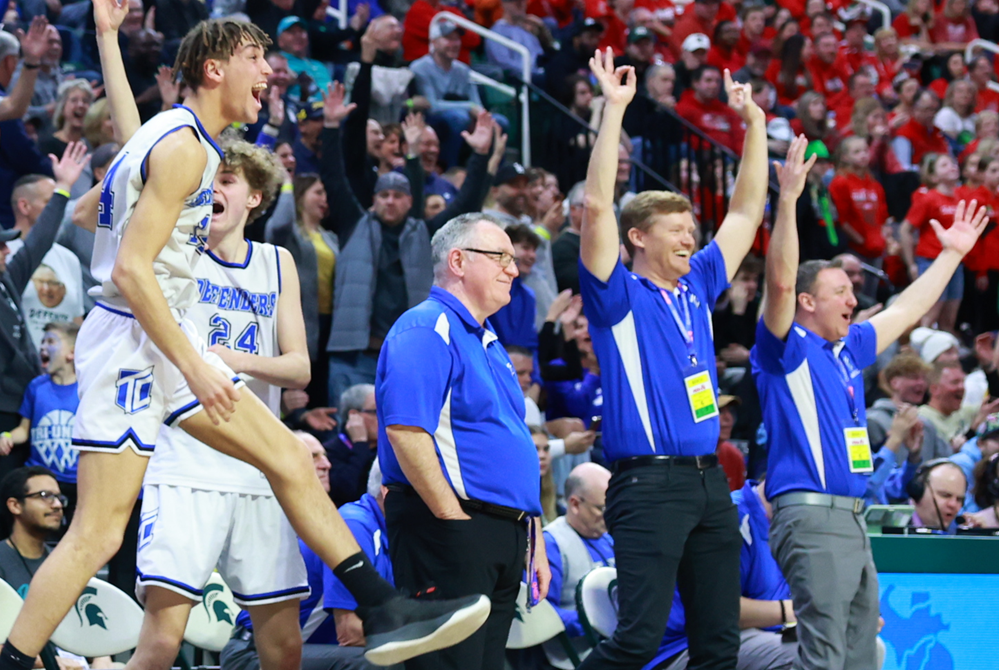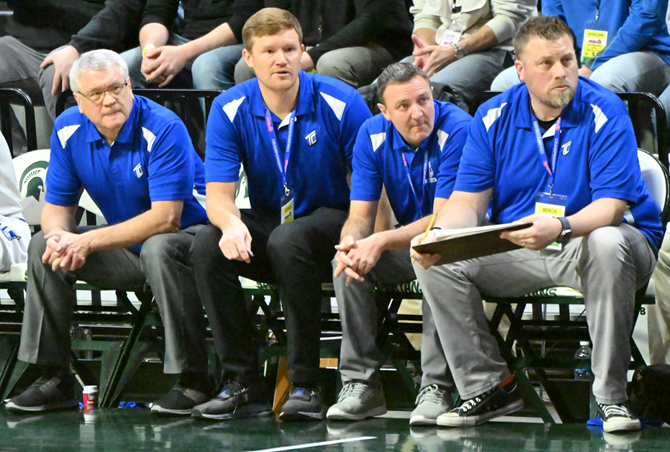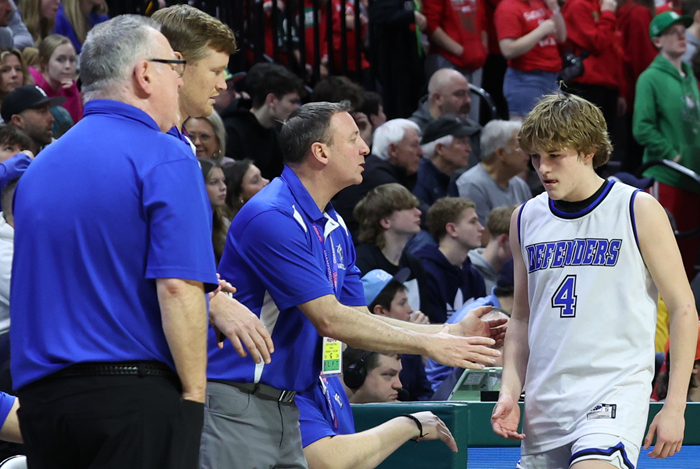
Turnaround Coaches: Study their Steps
April 27, 2016
 By Scott Westfall
By Scott Westfall
MSU Institute for the Study of Youth Sports
Turnaround leadership is often a popular topic within sports conversations, as many coaches are revered for their ability to transform a struggling team into a “winner.”
Turnarounds often are discussed in platitudes such as, “That coach has what it takes to turn this program around.”
While often talked about during the offseason, especially in the face of coaching vacancies, turnarounds are difficult to achieve. After all, if transforming a failing team into a successful one were an easy task, there would not be such an abundance of teams that struggle year-in and year-out.
As much as turnaround coaches are celebrated for their abilities to turn a losing program into a winner, very little scientific research has been devoted to analyzing coaches who have proven themselves as turnaround specialists. The steps and intangibles necessary for achieving a coaching turnaround have remained undetermined as this topic had never been examined from a scientific perspective – until now.
For the past year and a half, I have devoted the majority of my time to researching turnaround leadership in high school coaching, undertaking this study as the topic of my doctoral dissertation project. Research participants in this study included 11 high school football coaches from the state of Michigan who led dramatic turnarounds at their high schools within the last decade. The criteria for participant selection were:
• Prior to the coach’s arrival or appointment as head coach, the team finished (at least) three of the previous four seasons with a losing record (below .500 winning percentage), including a losing season immediately before the coach’s arrival or appointment.
• Within five seasons of the coach’s arrival, the team enjoyed (at least) three winning seasons (above .500 winning percentage).
Before their turnarounds occurred, these high schools had not experienced a winning season (on average) in 7.2 years, while five of the 11 schools had never qualified for the MHSAA Playoffs. However, upon being hired, the average time it took the coaches to achieve a winning record was 1.73 seasons. Moreover, the average time it took the coaches to qualify for the MHSAA Playoffs was 1.82 years. On top of this, each of the 11 teams qualified for the playoffs within three years of hiring their new coach.
The circumstances these coaches faced when they arrived were challenging to say the least, as all of the coaches entered a negative situation with poor team culture. These situations were characterized by losing streaks, cancelled seasons, dilapidated facilities, poor role models on the previous coaching staffs and a significant amount of parental pushback. Players and community members often were embarrassed by their football program. One coach described the situation by recounting, “During that time they were a doormat; everybody’s homecoming, a laughing stock. They were like the Bad News Bears.” Additional problems included low numbers, very little player development, and a low amount of commitment to the overall program.
One coach that I interviewed compared entering a turnaround situation to building a well. He stated, “You may not have success on the surface initially, but if you dig nice and deep and build the well right, there is water down there. It’s going to be some work and it might not come up right away – it takes some pumping. But if you build it right, it will happen.” In this article I will attempt to encapsulate 16 months of research, 191 pages of interview transcriptions, 2,278 miles driven across the state of Michigan, and countless hours spent with 11 turnaround coaches, in order to present to you the nucleus of what it takes to turn around a failing high school program.
The coaching philosophies of the majority of the coaches were characterized as “educational athletics.” This involved coaches striving to do things the right way, viewing their job as an extension of the classroom, implementing a character development program, and using football as a vehicle to teach life skills to players. Furthermore, their greatest strengths were revealed to be coaching/leadership skills, along with the ability to develop strong relationships with their players.
Coaches unanimously agreed that upon their arrival immediate changes needed to be made to the team’s culture. These changes included prioritizing team workouts, altering visible elements like the organization of practices, offensive and defensive schematics, team logos, along with placing positive role models in front of the players. Other changes to team culture happened through improved coach-athlete relationships, giving players a better football experience, and purging the program of negative people. One coach used the term, “Weeding the roses,” which means getting rid of the negative people in the program in order to let the better parts grow and prosper.
All of the coaches developed some type of vision for their program. The most common visions involved transforming their team into a top-level program, and for their players to conduct themselves as quality human beings. Winning games, competing with the best teams in their division, and playing for MHSAA championships marked becoming a top program. While winning was a major component of the coaches’ visions, developing quality human beings was revealed to be just as essential. This was evident as several coaches remarked that their most well-behaved kids were also their most productive players, and that doing things right in school and in the community often equates to wins on the football field.
To build upon their visions, each of the coaches formulated some type of plan or “blueprint” to execute their turnarounds. The majority of the coaches’ plans were constructed around developing positive coach-athlete relationships and employing off-season strength and conditioning programs. While all of the coaches’ plans eventually yielded a great amount of success, not all parties bought into them initially. Some of the players needed to see proof that the team could win games before they were completely sold. In order to create buy-in, the coaches used various approaches to connect with players and sell their plan. These methods included team activities, cultivating relationships with players, continuously selling their vision, hiring/retaining quality assistant coaches, and entering the situation with some sort of previous expertise. Although it may take time, the coaches stressed the importance of the players buying into their vision. As one of them decreed to his team, “The quicker you buy in, the quicker we win.”
Early indicators that a turnaround was commencing included winning games or making significant strides off of the field through positive coach-athlete relationships. Sources of sustained changes included a win streak or an increased level of commitment from the players. Clear indicators that the program had undergone a turnaround included the players adopting a new mentality filled with trust and confidence, along with the program reaching unprecedented levels of success, such as competing with the best teams, completing an undefeated season, and/or making the playoffs consistently.
Character development emerged as a strong component of this study, as 100 percent of the coaches reported that it played a significant role in fostering turnarounds. The coaches also indicated that they deliberately teach character in practice and use coaching as a platform for character development.
In hindsight, an outside observer may assume that these coaches were destined to succeed and their plans were met with little resistance. However, after examining their roads to turnaround success, most of them met several barriers along the way. Early obstacles included widespread mental challenges among players such as a lack of confidence and/or trust. Other early barriers included parental pushback and some cases of overt interference. After the turnarounds were complete, the coaches’ problems did not disappear; they simply changed form, as complacency became the new problem on the team. A potential root of this complacency was the addition of younger players who thought that success would happen automatically simply because of the program’s prior achievements.
The coaches were quick to acknowledge that the turnarounds would not have been possible without the excellent support they received. Their greatest source of help came from their assistant coaches who contributed both tangible and psychosocial support. Tangible support was seen through the assistants performing administrative duties and overseeing strength and conditioning sessions. Meanwhile, psychosocial support came in simple ways, such as listening, giving advice, and showing belief in the head coach. As one coach stated, “You’re only as good as the people you have around you.”
Team turnarounds are not officially complete until a team maintains the success it has built. In order to avoid complacency and sustain momentum, the coaches recommended that coaches and players find ways to keep reaching higher. In order to do this, coaches recommended talking to players about their team goals and what they want their legacies to be. To help sustain momentum, coaches stressed that it is often the little things that matter the most, such as effort, team discipline, player accountability, and positive attitudes.
The strongest theme that emerged from this study was the importance of coach-athlete relationships. All of the coaches believed that relationships are imperative to fostering turnarounds. It was also emphasized that relationships are crucial for sustaining long-term success. In essence, coaches may experience some momentary success by taking shortcuts with superior talent, however, strong relationships are the “X-factor” that will sustain the program over the long run. While the approaches of building relationships were diverse, what mattered most was coaches spending time with players in both structured and unstructured team activities, and simply showing players that they cared about them as people as much as they did as football players.
Steps of a Turnaround
(When turnarounds happen, they usually happen in this order)
1. Establish new leadership
2. Assemble a staff of positive role models
3. Gather information about the program
4. Create the vision
5. Make a plan and communicate it
6. Create buy-in from players and other key people
7. Change behavior – This is the impetus of the turnaround
8. Create and celebrate early wins
9. Don’t let up – Keep setting new goals and reaching higher
10. Complacency is the enemy: Make sure change sticks!
Intangibles Checklist
(These are the little things that people cannot see or do not talk about, yet they often matter the most)
1. Positive relationships between coaches and players. Build these by spending time with players and showing them you care about them as a person.
2. Establishment of a strength and conditioning program. All successful turnarounds were led by coaches who implemented a respectable offseason training program.
3. Display an undeniable belief that your vision and the plan will produce successful results. Continuously sell your plan and give players the reasons behind why you do what you do. Be prepared to stand tall and adhere to your vision when adversity strikes.
4. Generate player buy-in through team activities. Remember that sports are supposed to be FUN. Plan structured and non-structured activities to generate fun, excitement and team cohesion!
5. Demand excellence of your players off the field. Promote educational athletics and use your platform as a coach to teach character and life lessons to your players.
6. Outwork your opponents in everything you do. Arrive earlier. Stay later. Go above and beyond what your competitors are doing. Set the tempo that hard work is the new norm and it starts with you.
7. Remember that the little things matter. Take the time to ensure that your team always has the right effort, attitude and discipline, as well as accountability to the program and each other.
Scott Westfall spent 10 years as a teacher, coach, and athletic director in Fort Collins, Colo. He is currently finishing his Doctorate at Michigan State University, with an emphasis in Sport Psychology and Athletic Administration, and assisting the MHSAA with its student leadership programs. Westfall is a former athlete who participated in football, wrestling, tennis and cross country at the high school level, and rugby at the collegiate level. Please feel free to contact Scott if you would like a copy of his full dissertation. Scott also performs speaking engagements at conferences on various topics within educational athletics. He can be reached at [email protected]

Championship Experience from Coach's Point of View Unimaginable, Unforgettable
By
Dean Holzwarth
Special for MHSAA.com
April 4, 2024
WYOMING – As the final buzzer sounded, it was all I could’ve imagined – and more.

In the weeks leading up to March 16 and the Division 4 championship game, I experienced every emotion possible as I envisioned what it would feel like to be an assistant coach on the bench at Michigan State’s Breslin Center as the Wyoming Tri-unity Christian boys basketball team achieved its ultimate goal.
In my first year as the junior varsity coach at Tri-unity, I had been on the varsity bench for a majority of the season, assisting legendary coach Mark Keeler and fellow assistants Brent Voorhees, Bob Przybysz and Mike Kaman.
I was there encouraging, motivating and supporting the varsity team. It was a role I embraced, and had become accustomed to over my almost 30 years coaching high school basketball.
I started coaching in 1995 as Jim Ringold gave me my first opportunity as the freshmen girls coach at Wyoming Kelloggsville High School. I would then coach Kelloggsville’s freshmen boys team for eight seasons, while also coaching the freshmen girls at Grandville High School. I would also coach the junior varsity teams at both schools.
I love coaching. I have a passion for it. I’ve always enjoyed getting the most out of my players while creating a bond between player and coach.
When girls basketball season moved from fall to winter joining the boys in 2007-08, I stayed at Grandville. I spent 21 seasons there before stepping down.
I still wanted to coach, and I heard that the Tri-unity junior varsity position was available. I had always respected and liked Keeler and was excited for the prospect of joining a perennial powerhouse.
I didn’t really know about Tri-unity growing up in the Wyoming Park school district. But as a young kid, I would rush home and eagerly await the afternoon delivery of the Grand Rapids Press. I would quickly find the sports page and read it from front to back, hoping one day to see my byline.
I began writing for the Press’ sports department in 1997. It was my dream job. And that’s also when I first started covering Tri-unity boys basketball.
I remember watching eventual NBA all-star Chris Kaman, along with Bryan Foltice and others play for this little Christian school and have unbridled success under Keeler.
MHSAA Tournament runs became the norm for the Defenders. They won their first Finals title in 1996, and they would claim four more over the next 26 years. They also had six runner-up finishes.
 I was sitting on media row writing for MHSAA.com in 2022 when Brady Titus led Tri-unity to its fifth state championship.
I was sitting on media row writing for MHSAA.com in 2022 when Brady Titus led Tri-unity to its fifth state championship.
I never thought that two years later I would be on the coaching staff as the Defenders pursued another one. But there I was.
I knew this year’s team had the potential to be special.
Tri-unity had returned four of its five starters from a year ago, after suffering a heart-breaking two-point loss to Munising in the Division 4 Final.
Eight seniors were on the roster. The team had a mix of talented guard play, senior leadership, size and depth. We had shooters and we played great defense, a trademark of Keeler’s teams.
This was the year, and that heaped lofty expectations on Keeler and the team. It was basically “state championship or bust.” Anything less would be considered a disappointment.
Keeler wanted it badly, and I knew the players did as well. I think they felt the pressure at times of living up to the expectations that had been set.
We had several lopsided wins, but also had a few tough losses to Division 2 and Division 3 teams – Grand Rapids Forest Hills Central, Wyoming Lee, Grandville Covenant Christian and Schoolcraft – all talented teams that I think made us better despite falling short.
As the postseason started, there was anxiety and excitement.
We were one of the favorites, but it wouldn’t be easy. We would have to earn each of the seven victories needed to win it all.
First came a District title, but then we had to play a quality Fowler team in its home gym in the Regional Semifinal. This was a game we knew would be a challenge – and it was.
We led by only one at halftime after a 7-0 run to end the second quarter. The score was tied 33-33 in the fourth quarter before senior Lincoln Eerdmans made a key 3-pointer to spark our victory.
As we went through the handshake line, several Fowler players said, “Good luck in the Finals.”
Our defense played extremely well in the Regional Final and state Quarterfinal to secure our team another trip to the Breslin.
St. Ignace was our opponent in the Semifinal, and we had to face a senior guard who could do it all – Jonny Ingalls. He lived up to the hype. He was good, and we didn’t have any answer for him in the first half. We trailed by one, only to fall behind by seven late in the third quarter.
Was this the end? Were we going to fall one game short of our goal?
 We were down by five points in the fourth quarter, but junior guard Keaton Blanker, and others, rose to the occasion. We rallied to win a tight one, and now we were one win away from a Division 4 title.
We were down by five points in the fourth quarter, but junior guard Keaton Blanker, and others, rose to the occasion. We rallied to win a tight one, and now we were one win away from a Division 4 title.
The night before the championship game, we stayed at a hotel in East Lansing as we had the first game of the day at 10 a.m. We had a team dinner, and the players seemed relaxed and eager to close out the season the way they had intended.
There was one thing that worried me. We were playing Mount Pleasant Sacred Heart. A team we had played in the second game of the season and defeated by 30 points.
Would we be overconfident? I had no idea. They were a different team now, but so were we. Anything could happen.
Keeler gave a spirited and emotional pregame speech. In last year’s loss to Munising, he felt like the team played not to lose, and this season his big thing was “I want to win.” He said it to every starter that Saturday morning during the final moments in the locker room before tipoff, asking all five individually to say it back – which they did, the first one quietly but followed by teammates replying louder and louder as everyone got fired up and “I want to win” rang through the locker room. I think it inspired all of us.
After a competitive first quarter, we started to find our rhythm and expanded the lead. We were ahead by double-digits at the half, and a state title was within our grasp. Senior Wesley Kaman buried a 3-pointer in the final seconds of the third quarter to give us a 20-point cushion. It was at that point I knew we were going to win.
All five starters reached double-figure scoring, led by Jordan VanKlompenberg with 19 points and Owen Rosendall with 14. That balance was intentional and a successful sign for our team all season.
The exhilaration of winning was intoxicating. I loved watching the boys celebrate something they had worked so hard to accomplish. I will never forget their faces. I looked to my right from my seat on the bench and watched them running onto the court, just wearing their joy. They were just elated.
I was so happy for Keeler, a devout Christian who is respected by so many people in high school basketball circles. I learned so much from him this season. The way he approaches each game, his competitiveness. He instills his strong faith in his players and understands that the game of basketball is a bridge to a higher purpose.
Keeler is the fourth-winningest coach in state boys basketball history with a record of 694-216, and will be the winningest active coach next winter as all-time leader Roy Johnston retired from Beaverton at the end of this season.
The tournament run was one of the best coaching experiences I have had, and I feel blessed to have had the opportunity to be a part of a state championship season.
 Dean Holzwarth has covered primarily high school sports for Grand Rapids-based WOOD-TV for five years after serving at the Grand Rapids Press and MLive for 16 years along with shorter stints at the Ionia Sentinel and WZZM. Contact him at [email protected] with story ideas for Allegan, Kent and Ottawa counties.
Dean Holzwarth has covered primarily high school sports for Grand Rapids-based WOOD-TV for five years after serving at the Grand Rapids Press and MLive for 16 years along with shorter stints at the Ionia Sentinel and WZZM. Contact him at [email protected] with story ideas for Allegan, Kent and Ottawa counties.
PHOTOS (Top) The Wyoming Tri-unity Christian bench, including the author (far right) and head coach Mark Keeler (middle), celebrate a 3-pointer late in the Defenders’ Division 4 championship win over Mount Pleasant Sacred Heart. (Middle) Tri-unity’s assistant coaches, including Holzwarth (second from right), monitor the action. (Below) Holzwarth and the coaching staff greet Keaton Blanker (4) as he comes off the floor. (Photos by Hockey Weekly Action Photos.)

